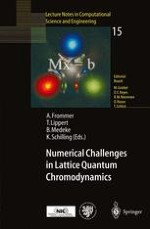2000 | Buch
Numerical Challenges in Lattice Quantum Chromodynamics
Joint Interdisciplinary Workshop of John von Neumann Institute for Computing, Jülich, and Institute of Applied Computer Science, Wuppertal University, August 1999
herausgegeben von: Andreas Frommer, Thomas Lippert, Björn Medeke, Klaus Schilling
Verlag: Springer Berlin Heidelberg
Buchreihe : Lecture Notes in Computational Science and Engineering
Enthalten in: Professional Book Archive
